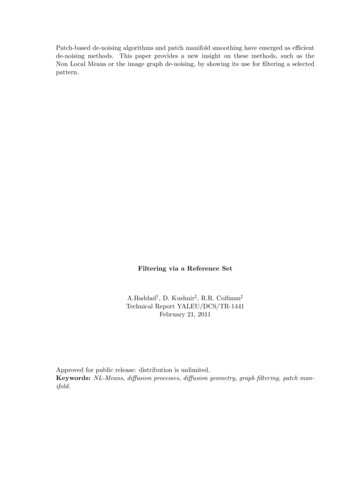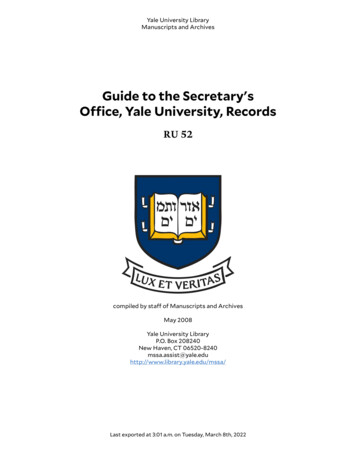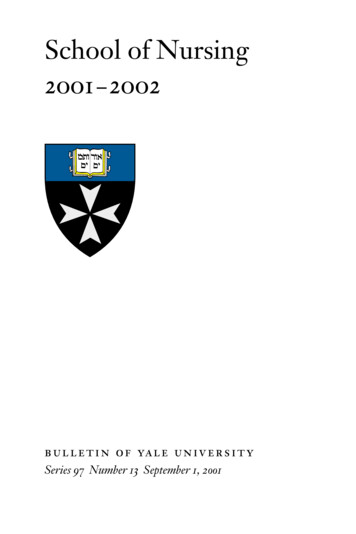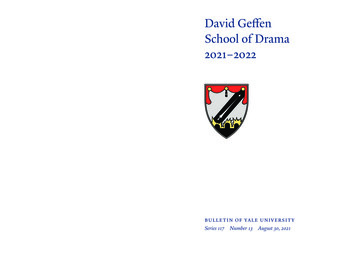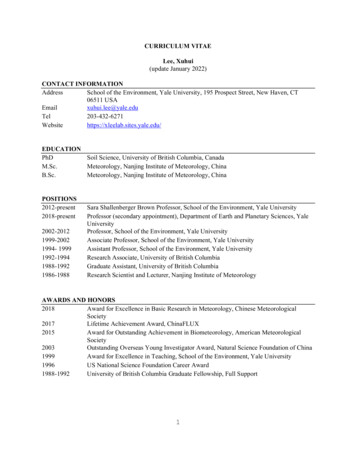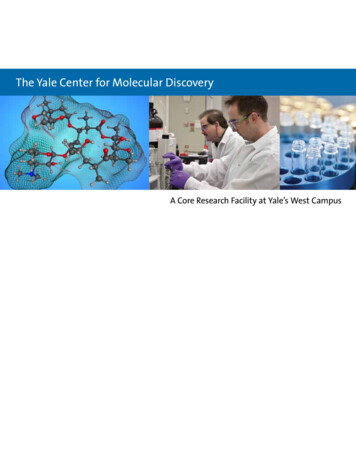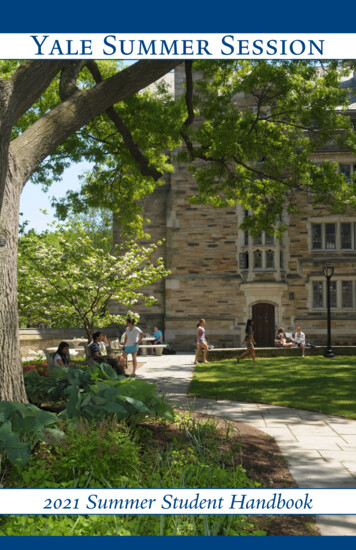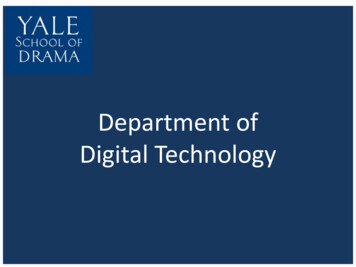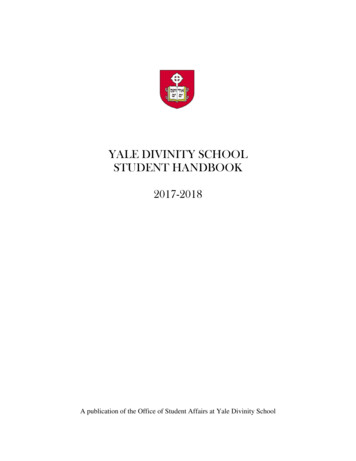
Transcription
2016ITS Annual ReportEnabling InnovationInformation Technology Services
table of contentsyale information technology services annual report 2016message from the cio 3insights 4IT Support of Research Grows at Yale 4A Stronger, More Usable, and MoreAccessible Yale Web 7Journey to the Cloud: Opportunties,Challenges, and Risks 9technology for the community 13Bringing HD Streaming, Recording toYale Squash 13Piecing Together the Life of theBuddha 14More Acomplishments 15core services 17Unifying University Business WithWorkday@Yale 17Protecting Yale’s Data withMultifactor Authentication 19More Accomplishments 21partnering and outreach 23Nurturing Young TechnologistsThrough Internships 23Yale Information Technology ServicesYale Universityits.yale.eduConnecting Doctors and PatientsThrough Video Technology 2525 Science Park150 Munson St., New Haven, CT 06520More Accomplishments 26new & improved services 29cio spot awards 31ITS Help Desk: 203-432-9000helpdesk@yale.eduFor additional media, visitfy16.itsannualreport.yale.eduInformation Technology Services1
2
Message from the CIOWelcome to our Fiscal Year 2016 ITS AnnualReport. In these pages, you will find storiesof how ITS has enabled, and continues toenable, innovations throughout the University.From the Child Study Center, to The Lifeof the Buddha project, to the Brady SquashCenter, ITS has worked with members ofthe community to find solutions to meet theuniversity’s wide-ranging technology needs.In recent years, President Peter Saloveyhas emphasized the importance of innovationat Yale in his efforts to build a more excellentuniversity. The 2015 Yale Technology Summithighlighted many of these innovations,and more will be featured at the 2016 YaleTechnology Summit on October 28.At its core, Yale ITS is a serviceorganization. We aim to provide high-qualitytechnology services to the Yale community,and in doing so we recognize how we directlyand indirectly enable and support theinnovations happening at Yale.On behalf of IT professionals acrosscampus, I invite you to peruse the 2016 ITSAnnual Report and encourage you to learnabout the many ways we support a moreconnected, open, innovative, and excellent YaleUniversity. I also encourage you to browse theextensive list of ITS services available to youby visiting its.yale.edu/services.Len PetersUniversity Chief Information OfficerAssociate Vice President3
insightsIT Supportof ResearchGrows at YaleKiran KeshavExecutive DirectorYale Center for Research ComputingSenior DirectorITS Research TechnologiesAs the Yale community forges ahead inconducting cutting-edge research acrossdisciplines, research computing support atYale must continue to innovate to supportthese research breakthroughs.The Yale Center for ResearchComputing’s Inaugural YearWith the creation of the Yale Center forResearch Computing (YCRC), FY 2016marked the beginning of a new era inresearch technology support at Yale acrossthe Faculty of Arts and Sciences and theYale School of Medicine. In response tothe needs of the research community, thecenter focused on advancements in fourareas: cyber-infrastructure, education andtraining, advanced support, and community development.In order to serve its mission and maximize accessibility to the broader scientific community, the YCRC moved into acreative space near Science Hill at 160 St.Ronan Street. The center’s new space cameequipped with its own auditorium for4seminars and workshops. In addition, theYCRC solidified its governance structureby creating the YCRC Steering Committee.This governance board includes facultyfrom a broad range of disciplines, and ishelping guide the direction of the YCRCinitiatives.Cyber-InfrastructureThe YCRC helped keep researchers atthe forefront of their computationallydemanding fields by taking advantageof newer High Performance Computing(HPC) technologies. Two HPC clusterswere refreshed in FY 2016.The first, Ruddle, named after famousYale biologist Frank Ruddle, is a refresh ofBulldogN, which serves the Yale Center forGenome Analysis. Ruddle was acquiredthrough a successful National Institutes ofHealth award, and has significantly enhanced computational power compared toBulldogN, adding 400 cores and roughly apetabyte of additional high-performancestorage.Insights
tive and advanced technologies. The YCRCThe second cluster, Farnam, named afterran its first set of skill-building workshopsLouise Whitman Farnam, the first womanin FY 2016, taught by YCRC members andadmitted to the Yale School of Medicine, isexperts from our vendors. Topics includeda refresh of the Louise cluster, which servesIntroduction to HPC, Scripting with Pythe general Life Sciences community.thon, Amazon Web Services for Research,In addition to these refreshes, the HPCand HPC training through XSEDE.team created Milgram, named after theRecorded training sessions and anSocial Psychologist Stanley Milgram, for usenouncements of upcoming events areby the Department of Psychology. Milgram’savailable at research.computing.yale.edu/deployment is a milestone for Yale researchtraining.infrastructure, as it represents the first HPCcluster specifically designed for the privacyAdvanced Supportrequirements of HIPAA-protected data.This small, 12-node cluster with roughlyMany members of the faculty need to work150 terabytes of storage is serving as a pilotcollaboratively with computational refor HIPAA alignment and could be expandsearchers to make the most efficient use ofed in the coming years.the research computing infrastructure onThe YCRC also has been partneringcampus. The YCRC continued to providewith researchers in the Department ofdedicated advanced support for the YaleComputer Science and with Yale ITS to exCenter for Genome Analysis, as well aspand the Yale Scienceincreased levels ofNetwork, a high-speed “The constant exchange ofsupport for sevnetwork specificallyeral departmentsdesigned for large data ideas across disciplines isand disciplines,transfer. Currently,crucial to fostering innovationincluding Geologythere are more than 15& Geophysics. Theand creating opportunities forresearch labs conYCRC supportintellectual surprise.”nected to the Scienceed RosenkranzNetwork.grants involvingAs the networkan orbital simulator and Mathematica toolsinfrastructure expands in FY 2017, thefor the demonstration of genetic drift, andproject also will aim to create an intelligentit served as a resource for faculty hires innetwork using software. The developmentPsychology, Genetics, the Systems Biologyof this software-defined network, led byInstitute, and Chemistry.Yale researcher Richard Yang, will allowThe Science Research Software Corethe current campus network to interface(SRSC) also was made available as part ofseamlessly with the Science Network and,the YCRC’s service offerings. The SRSCas the Science Network grows and becomeswas implemented previously by the Promore widely used, will allow for intelligentvost’s office in recognition of the demandutilization of the network to keep datafor cutting-edge software for use in analyttransfers speedy and efficient.ical and experimental research, design, andanalysis. The software supported by theEducation and TrainingCore is specifically applicable to the fieldsof Physics, Applied Physics, Chemistry,Researchers need continuous updating ofComputer Science, Geology and Geophystheir skills in order to use the most innovaInsights5
ics, and Engineering. A full list of supported software titles, and the support contact,are available at are.CommunityThe constant exchange of ideas across disciplines is crucial to fostering innovationand creating opportunities for intellectualsurprise. As part of its efforts to build aninterdisciplinary research computing community, the YCRC was involved in the Dayof Data 2015: Innovation through Collaboration. Keynote speakers Robert Grossman(University of Chicago) and Chaitan Baru(National Science Foundation) presented,respectively, on Big Data Analytics: FiveTrends and Five Challenges, and DataScience R&D: Current Activities, FutureDirections.The YCRC also has been involved innational developments on the role of thecyber-practitioner, the Northeast Big DataInnovation Hub, and various faculty-ledworking groups to better understand andalign with the computational needs oncampus.Contact Kiran Keshav atkiran.keshav@yale.edu6
A Stronger,More Usable,and MoreAccessibleYale WebJane LivingstonAssociate CIOCampus Community TechnologiesThis essay was co-written by MichaelHarris, Information Architect, CampusCommunity Technologies.An excellent web is integral in supportingYale’s mission of creating, disseminating,and preserving knowledge. Yale ITS’s support for the web enables the University toeffectively communicate with the community and the larger world. As Yale continuesto improve the way people experience Yale’sonline environments, sharing and accessinginformation will only become easier. We’reproud of the strides we made in the pastyear and of the value we have contributed toYale through supporting the community inbuilding better online spaces.Better Websites, Better ContentManagementEffective stewardship of Yale’s web increasingly requires a strong content management system, and Yale has increased itscommitment accordingly. In FY 2016, theWeb Technologies team migrated hundreds of websites from outdated, non-re-sponsive, static formats to YaleSites (builton Drupal) or CampusPress (built onWordPress) platforms, making them easierto maintain, update, and govern.YaleSites, as our primary web contentmanagement system, continues to be acritical asset for the university, powering most of its academic, administrative,research, and communications websites.ITS supported the Office of Public Affairsand Communications in the redesignand building of the new Yale.edu website,providing the YaleSites platform and technical expertise. The new site powerfullycommunicates to the world Yale’s missionand personality, thanks in large part tothe maturity, versatility, and robustness ofYaleSites technology.YaleSites released set of updatedthemes inspired by Yale.edu’s visual designthat allow any website around the university to align with the university’s new lookand feel. Formally announced at YaleSitesDrupalCamp, the new themes are alreadybeing used on sites such as the Office of theSecretary and the Department of Physics.Insights7
Yale has also improved the web technologies that power search functionalityon its websites. In addition to the nativesearch engines available in YaleSites andCampusPress, now available are GoogleCustom Search and Apache SOLR.SOLR is a powerful technology thatallows for faceted searches and powerfulfilters to return more helpful results. Withthese technologies, people using Yale’s webwill be better able to find the informationthey need.More Usable and AccessibleUser ExperiencesYale’s Campus Community Technologiesteams have built high-profile websitesfor the university, including sites for YaleCollege Undergraduate Admissions and theYale Divinity School. These websites, builton the YaleSites platform, reflect Yale’s commitment to superior user experiences andcustom visual designs for their audiences. The User Experience & Digital Strategyteam also provides consulting and designservices on projects across the university.In FY 2016, Campus CommunityTechnologies released an updated andvastly improved Online Directory, allowing users to quickly search individuals andorganizations across campus. The directoryautomatically provides search results basednot just on name but also job title, place ofwork, and institutional affiliation. Findingthe contact information for anyone at Yaleis much easier than it used to be, and Yale’sdirectory leads its peers in terms of itsusability.Yale Campus Community Technologiesalso built a new and improved campus mapthat provides easy and more modern access.Yale ITS has increased its commitmentto ensuring that its web is accessible for users with disabilities. ITS improved the accessibility of three important student-fac8ing websites—Student Life, ResourceOffice on Disabilities, and Center forTeaching and Learning—and will continueto improve web accessibility across the university as part of its ongoing mission. As aresult of those efforts, users with blindness,low vision, deafness, and motor difficultiescan access information on these sites aseffectively as users without disabilities can.In order to promote the value of userexperience throughout the university, ITSlaunched a Usability and Web Accessibilitywebsite. The website is designed to help allof Yale’s developers, designers, and editorslearn about and implement best practiceson all of their web projects, and the projecthas already garnered praise from aroundthe university.Continued Improvementfor Yale’s WebThe next fiscal year will bring even moreimprovements to Yale’s web. Yale ITS willbegin a new version of YaleSites built onDrupal 8, the newest release of Drupal.Leveraging Drupal 8 will increase thepower and flexibility of YaleSites, leadingto ever-easier website creation. In addition,ITS is moving the remainder of the webinfrastructure to the Aquia Cloud. ITS willalso engage with a vendor and consultantsto improve the accessibility of high-priorityuniversity websites and applications, helping users with disabilities to take advantageof all Yale has to offer, while also developingYale’s own capacity and talent to sustain apermanent commitment to accessibility.We are looking forward on buildingthe work we have done over the past yearto make Yale’s web stronger, more flexible,more usable, and more accessible.Contact Jane Livingston atjane.livingston@yale.eduContact Michael Harris atmichael.w.harris@yale.eduInsights
Journey to theCloud:Opportunties,Challenges,and RisksVijay MentaAssociate CIOInfrastructure ServicesThis essay was co-written by Rob Starr,Principal Solution Architect, InfrastructureServices.We are in the midst of exciting times fortechnologists around the globe. Infrastructure technologists in the higher educationspace are especially invigorated with theopportunities that are being presented bythe vendors in the cloud space. The opportunity to provide computing, storage,and resiliency at an unprecedented scalefor researchers, faculty, staff, and studentsis opening new doors for possibilities inresearch and collaboration that could nothave been imagined in the past. With theever-rising costs of education and financialconstraints surrounding the IT services inhigher education institutions, it is becoming increasingly difficult to manage datacenters or provide infrastructure at levelsthat researchers demand.Yale ITS has been on the path of a“Cloud First” strategy for more than fiveyears and has deployed many Software asa Service (SaaS) solutions that live entirelyin the cloud. These include ServiceNow(IT ticketing system), Workday (HumanResources ERP), Slate (student admissions), Qualtrics (survey tool), and Office365. In the past two years, we also madeheavy investments in PaaS offerings suchas Salesforce (contact center), Quickbase,and Acquia (Yale websites), and have beenmaking steady progress towards our CloudFirst strategy. For all our IT solutions, wehave been evaluating SaaS solutions beforeconsidering Platform as a Service (PaaS),then Infrastructure as a Service (IaaS), andfinally on-premises solutions.A few years ago, Yale ITS was managing more than seven data centers; thatnumber has been reduced to two data centers. The management and upkeep of datacenters is a considerable financial burden,and it has become increasingly difficultto provide reliable 24/7 support to ourever-growing IT infrastructure demands.Until recently, we were on a path of virtualization and had virtualized more than80 percent of our infrastructure. However,the agility, reliability, and flexibility provided by cloud vendors cannot be achievedwithin our current data centers withoutInsights9
vice and will continueto add capabilities andgrow. Although thenumber of servicesavailable today aresmall, we have developed an architecturethat allows us to scaleand add new serviceseasily and exposeSelf-service automation for storage andthose services behindcomputingan API for users toAbility to expand and reduce computeconsume.and storage capacity with geo-redunWhile public anddancy and resiliencyprivate clouds offerMetered pricingautomation, Spinupaims to fully autoStaff development training to foster themate the configuration of systems to makedevelopment of a culture of creativitythem directly consumable by the end user.and innovationSelf-service is reallyLet us examine theabout enabling IT“With the ever-rising costs ofabove in additionalconsumers to getdetail as we makeeducation and the financialthings quickly andour journey to thereliably. We want toconstraints surrounding thecloud.enable innovation,IT services in higher educationmaintain security,Self-serviceinstitutions, it is becomingenhance resiliency,Automationincreasingly difficult to manage and remove barriers.Self-service is at thedata centers or provideheart of the CloudAbility toFirst strategy. When infrastructure at levels thatExpand/Reducemost technical leadComputing andresearchers demand.”ers think about theStorage Capacitycloud, they are notTo make the cloud most effective, we needenvisioning an environment with multito deploy applications that can shrink andple ticket handoffs and an administratorgrow based on utilization and that can repdeploying a system at the end; they arelicate across zones or regions for resiliency.hoping for fully automated deployments.We need to build applications based onAutomation is the key to realizing theservices instead of servers. Users need tobenefits and building a solid culture of enhave the ability to delete or turn off envigineering and innovation. Spinup, a portalronments when they are done using themand API that gives individuals the ability toand view these resources as disposable. Weprovision virtual machines and applicationneed them to build application environenvironments on a variety of infrastructurements that take advantage of auto-scalingecosystems, is our first attempt at self-sersignificant financial investments.We recently started our journey of ourinfrastructure to the cloud and have initiated the migration of our data-center-hosted infrastructure to the cloud. We anticipate this journey to take a minimum ofthree years, but are excited by the countlessopportunities migration to cloud will offer.These include:10Insights
to use only the computing resources needed. This is a completeshift in paradigm ofour usage of our hardware resources whereour non-productioninstances are practically up 24 hours a dayand 365 days a year.Metered PricingThe pay-for-what-youuse model allows us toconsume computingresources similar toour utilities and allowsus to be more fiscally responsible. Vendorsoffer deep discounts for infrastructure thatcan be reserved for a significant length oftime when the usage is predictable. Cloudvendors such as Amazon and Azure, majorplayers in this space, have been able tooffer reduced prices year after year due togrowing demand and a practically unlimited supply of infrastructure facilities thatare in their control.coming years, we are looking forward todeveloping staff members who can collaborate across various IT groups and breakdown the barriers between infrastructureand application teams to build a strongDevOps culture.Staffing and Service AlignmentUsing the cloud as a catalyst to reorganizeinternal operations has been a popularstrategy. But the idea that using the publicor private cloud will result in simplifyingoperations is misguided. Each cloud hasan entire ecosystem that accompanies it,and to fully take advantage of the cloud weneed to build expertise in the cloud toolingand architecture.The following key factors will helpdrive staff and service alignment:Services are not limited to thoseprovided to clients; services can beinternal, such as backup, monitoring,patching, storage, compute, andnetworkEvery service needs an owner (teamor person) and that owner drives thestrategic directionStaff DevelopmentMoving an on-premises data center to thecloud presents an opportunity for traditional infrastructure system administrators, database administrators, networkengineers, and application developers todevelop new skills and provides an opportunity for creative and innovative waysto test new scenarios not possible in anon-premises environment. For example,a developer who wanted to simulate aproduction instance could easily stand upand dismantle the infrastructure for testingat minimal cost and avoid having to guessif the application and infrastructure couldstand up to the anticipated load. In theService owners are responsible for theavailability, resiliency, and security oftheir servicesEach cloud service we offer eitherinternally or externally needs a serviceowner and a support structureCloud RisksMigration to cloud comes with its own setof risks that are quite different from managing on-premises data center infrastructure. They range from data storage andtransmission risks to fluctuating operatingcosts to legal and compliance risks. The listbelow is a high-level summary of risks thatwe will evaluate during our journey.Insights11
Security RisksInfrastructure securityData storage and transmissionIncident responseProliferation of infrastructureControl verificationOperational RisksDisaster recoverVendor lock-inThird-party vendor relationshipsFinancial RisksFluctuating operating costsFinancial complexityBusiness case and justificationLegal and Compliance RisksProtection of intellectual propertyNotification of legal processSoftware licensingIndemnify institutionsSource: Cloud Strategy for Higher Education: Building aCommon Solution. Research bulletin. Louisville, CO:ECAR, November 5, 2014.Exit StrategyTo discuss about our exit strategy beforewe have even completely migrated intothe cloud may seem premature. However,having a solid exit strategy that providesa well-documented process for movingdata and applications back to on-premisesinfrastructure or even to a different cloudvendor is something that we plan on paying particular attention to in our journeyto the cloud.Contact Vijay Menta atvijay.menta@yale.eduContact Rob Starr atrobert.starr@yale.edu12
technology for the communityBringing HD Streaming,Recording to Yale SquashAV systems broadens audience, enhances coachingYale Athletics may not come to mind whenthinking of departments with a demandfor technology at Yale. Technology insports, however, is booming, from wearables that help athletes and fitness enthusiasts track effort, to software and systemsthat that assist athletes in optimizing theirperformance, to websites and mobile appsthat build fan engagement.In FY 2016, Yale Squash coaches engaged Yale ITS for help in bringing newtechnology into the squash courts at theBrady Squash Center in Payne WhitneyGymnasium. The coaches wanted to implement high-definition recording and onlinestreaming of practices and matches.ITS AV Engineering consulted on theproject and managed the installation andupgrades. The project included installinghigh-definition cameras on 14 of the facility’s 15 courts, streaming and recordingequipment, a central command station,and a public address system in each courtthat allows a coach in the command station to communicate with the players. Inaddition, the project team installed screensthat can display scores from each court atthe facility and game play on other courts.The squash team’s short-term goal wasto be able to stream the Ivy League SquashChampionship, hosted by Yale, over the IvyDigital Network, allowing thousands moreviewers to enjoy the matches. However,the benefits of the new AV system went farbeyond expanding the team’s audience. Thesystem has enhanced both coaching andrecruitment of top athletic talent.“We wanted to really up the way weteach,” said Pam Saunders, Yale SquashAssociate Head Coach. “We thought thiswould be helpful in terms of teaching ourkids the tactical errors they are making,as well as the technical errors they aremaking. You need to really see what you’redoing in order to change.”The project team completed the installation in time to stream Yale Squash’s victory in the Men’s Squash National Championship.The system will be used to stream othertournaments, such as the U.S. Junior Open,Saunders said. “This is going to allow alot of parents access and will help give thesport much better visibility.”Several other squash facilities are looking at Yale’s system as they plan their ownupgrades to offer similar capabilities.Watch the related video atfy16.its.annualreport.yale.eduTechnology for the Community13
Piecing Together the Lifeof the BuddhaTechnology allows online study of Tibetan muralsThe Life of the Buddha is a ground-breaking project to study a series of monumentalTibetan murals that tell a story of theBuddha’s life. Led by Andrew Quintman,professor of religious studies at Yale andscholar of Tibet and Tibetan Buddhism,and Kurtis R. Schaeffer, professor of religious studies at the University of Virginia,the grant-funded project includes thecreation of a digital tool that will bringtogether images and text, allowing studentsand scholars online access to materialsand the ability to study the murals andliterature in context. The murals, createdin the early 17th century, are located in amonastery in Central Tibet and have neverbeen visually documented. Their narrativespans the Buddha’s life from birth to death,detailing his teaching and wanderings.ITS’s Campus Commnity Technologiescollaborated with the project team to adaptMirador, a platform developed at Yaleand Stanford that enables online collaborative annotation of text and images, tomeet the needs of the Life of the Buddha14project. Mirador had not been used tohandle images as large the murals, and thesystem needed to be configured to handlemultiple layers of annotations and link totext sources. ITS took on the painstakingtask of preparing the digital images forstudy. The work involves stitching togetherhigh-resolution photographs of the murals,which cover 1450 square feet, and correcting differences in color and perspective.“The Life of the Buddha will create aplatform that is not only an exciting environment for researchers and scholars, butalso for teachers, students, and classroomlearners, and eventually the broader publiccommunity,” Prof. Quintman said. “That’sthe kind of multimodal use that wouldhave been very difficult without the collaboration with a top-notch IT team.”Work is continuing to annotate the 15panels and prepare them for Mirador. Tolearn more, visit lifeofthebuddha.yale.edu.Watch the related video atfy16.its.annualreport.yale.eduTechnology for the Community
TECHNOLOGY FOR THE COMMUNITYMORE ACCOMPLISHMENTSNew Platform for Admissions DecisionsDynamic Digital Displays for CSSSIThe South Reading Room of the Centerfor Science & Social Science Information(CSSSI) features a large multi-screendisplay that showcases Yale history,research activity at Yale, and Universityprojects and initiatives. Curated by thecenter’s librarians and created by a seniordesigner on the ITS User Experience &Digital Strategy team, the dynamic exhibitsincorporate images, text, and video. “TheAfrica Initiative at Yale: Research in theSciences and Social Sciences” is on displaythrough October 2016.Clover Mobile Point-of-Sale SystemITS facilitated the rollout of Clover, a mobilepoint-of-sale (POS) system that has beenadopted by departments across campusthat perform sales transactions. Theplatform offers a range of hardware, froma traditional cash register to a fully mobilehandheld terminal with wireless network or3G connectivity. Features include inventorytracking, a web-based administrationportal, and support for the new EMV (chip)credit cards and Apple Pay.ITS Student Academic and SupportSystems and Undergraduate Admissions(UGA) partnered to move the admissiondecision process from a custom ITSmanaged application to a vendor product,Technolutions’ Slate. The first decisionrelease through Slate was on December15, 2015. ITS has been building integrationsto allow applications to be read in Slatestarting with the Class of 2021.Change ManagementCommunity ResourceITS OrganizationalChange Management(OCM) introduced awebsite for ITS andmembers of the Yalecommunity in need ofchange managementinformation andsupport. The siteprovides an overviewof the framework andmethodology used toimplement change at Yale, and includeschecklists, templates, and samples frompast projects. The site also providesinformation on the Change Community ofPractice and on how to engage the OCMteam for services.Yale Aviation Club Flight SimulatorITS Public Computing Services partneredwith the operations manager of SaybrookCollege to find a new home for the YaleAviation Club’s two flight simulators,which were to be put into storageand inaccessible to the public duringrenovations at Saybrook. Public ComputingServices moved the simulators to a newpermanent home in the Morse/StilesCollege cluster space, where studentsinterested in aviation can continue theirtest flights.15
Visiting Scholars Appointment TrackingITS Campus Community Technologiesassisted the MacMillan Center forInternational and Area Studies indeveloping a new way of monitoringvisiting scholars from appointment todeparture. The VS Appointment RequestTracking System, developed on theSalesforce platform, replaced manualprocesses and consolidated information inspreadsheets, email, and text documentsinto a single repository. The system, whichwas delivered in only 75 hours, offers aconsistent and more efficient approach,at-a-glance request status, and enhancedreporting capabilities.Application Virtualizationfor the School of Public HealthITS Public Computing Services has createda partnership with the Yal
of newer High Performance Computing (HPC) technologies. Two HPC clusters were refreshed in FY 2016. The first, Ruddle, named after famous Yale biologist Frank Ruddle, is a refresh of BulldogN, which serves the Yale Center for Genome Analysis. Ruddle was acquired through a successful National Institutes of Health award, and has significantly en-

